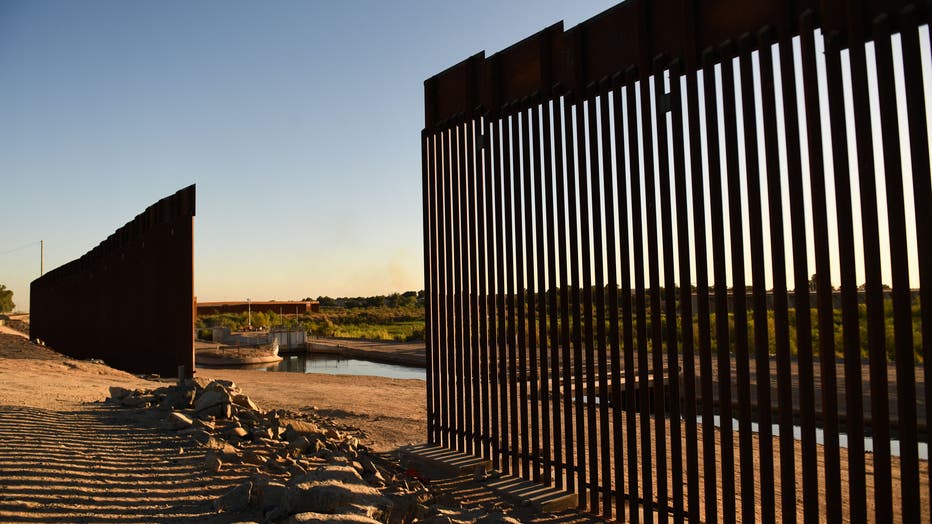US to fill border wall gaps in Arizona for safety reasons
Biden administration gives green light to fill gaps in Arizona border wall
Border officials got the go-ahead Thursday to fill four remaining gaps in the U.S.-Mexico wall near the southern Arizona community of Yuma to protect the safety of migrants and U.S. agents working there.
PHOENIX - Border officials got the go-ahead Thursday to fill four remaining gaps in the U.S.-Mexico wall near the southern Arizona community of Yuma to protect the safety of migrants and U.S. agents working there.
The Department of Homeland Security said in a statement that the work to complete a barrier project near the Morelos Dam is to protect the safety of migrants and its own agents. Border crossers have been killed or injured in the area by falling down a slope or drowning while walking across a low-level section of the Colorado River.
A 5-year-old migrant girl crossing the water in a group drowned near the dam on June 6 when she became separated from her mother. The child’s body was later found in the river.
U.S. officials didn’t release the girl’s identity or nationality. But Jamaican newspapers have said she was believed to be from that country.
Yuma is a popular crossing area for migrants in part because they can easily walk across the river, surrender to U.S. border officials and request asylum.
"Due to the proximity to the Morelos Dam and the swift-moving Colorado River, this area presents safety and life hazard risks for migrants attempting to cross into the United States," said the statement announcing Homeland Security Alejandro N. Mayorkas had approved the work by Customs and Border Protection. It also noted dangers for its own agents.
MORE: Smuggler hoists girl over US border wall, returns to Mexico without her
Arizona environmentalist Myles Traphagen, who has been mapping ecological damage left by border wall construction under former President Donald Trump, said that closing the gaps won’t create much of a deterrent for migrants.
Traphagen said the Yuma area has "become the new Ellis Island for Arizona, with people arriving there from countries as disparate as Ethiopia, Cuba, Russia, Ukraine, India, Colombia and Nicaragua.
"People have traveled half way around the globe on planes, trains and automobiles," he said, "so to expect that closing four small gaps is going to make them turn around and book a return flight on Air Ethiopia is sheer fallacy."
It was unclear when construction would begin. The statement said officials will move "as expeditiously as possible, while still maintaining environmental stewardship" by consulting affected parties.
The gaps are inside an area for a barrier project previously funded by the Defense Department and will be paid for by Homeland Security appropriations for the fiscal year 2021.
Democratic U.S. Sen. Mark Kelly of Arizona has been pressing President Joe Biden’s administration to close the gaps near the dam as a safety measure. The work is also supported by local officials, including Yuma Mayor Douglas Nicholls, a Republican.
MORE: Autopsy: Woman migrant found entangled on border wall choked to death
Amid the push to close those gaps, environmentalists like Traphagen have called for removing some other sections of barrier they say have hurt local wildlife like bobcats, mountain lions, javelinas and mule deer.
The Tucson-based Wildlands Network this week released a new report on sites along the U.S.-Mexico border that it considers in the greatest need of environmental restoration.
Traphagen, the group’s borderlands program coordinator, traveled the international boundary across New Mexico, Arizona and California this and last year to identify damaged wildlife corridors and other environmental harm.
The group calls for native foliage to be replanted in areas that were stripped bare during wall construction, and widening spaces between steel borders, now just 4 inches apart, to allow more wildlife to pass through.
It also calls for the removal of 180 miles of razor wire that were installed along pedestrian bollard fencing in all border states in 2019 and 2020 both as an eyesore and a danger to the public and wild animals.

The sun sets behind a gap along the border wall at the Morelos Dam between the US and Mexico in Yuma, Arizona on May 31, 2022. (Photo by PATRICK T. FALLON/AFP via Getty Images)

